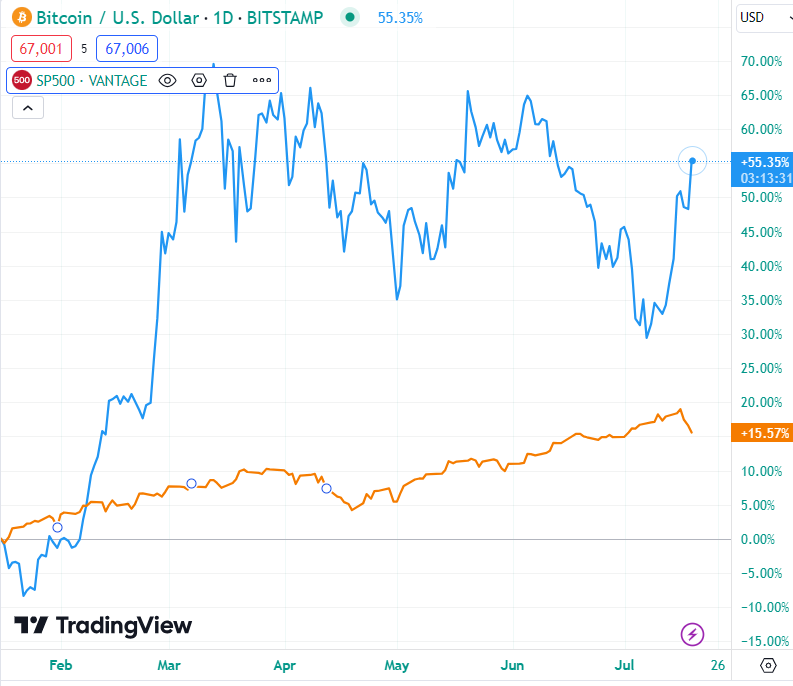Bitcoin’s correlation with the S&P 500 is at its highest in nearly two years, hitting 0.67, showing how both traditional and crypto markets are getting rocked by broader economic issues.
BTC dropped 10% after weak U.S. job data but recovered some ground, ending the week down by 3%. Ethereum also struggled, finishing the week with a 7% loss.

The S&P 500 and Nasdaq have had a rough September too, and the upcoming CPI report and the Federal Open Market Committee (FOMC) meeting on September 18 are likely to impact this growing connection even more.
CME and offshore markets
Futures premiums on the CME have stayed pretty flat, sticking near their lowest points of the year. The term structure is moderate, and open interest hasn’t really moved much this past week.
Offshore, traders are still leaning bearish, with perpetual funding rates dropping to their lowest since March 2023.
Rising open interest—now at levels we haven’t seen since July—paired with these negative funding rates, tells us the market could be setting up for some serious short squeezes.

With FTX’s bankruptcy confirmation hearing coming up on October 7, repayments between $14.4 billion and $16.3 billion might start as soon as Q4 or Q1 2025.
FTX has already converted its crypto assets to dollars, so any leftover sell-side pressure is probably gone.
Around $8 billion from these repayments is expected to come back into the crypto market, with an estimated 20-40%—or about $1.6 billion to $3.2 billion—likely to be reinvested in crypto.
Perp funding rates show market shifts
There are signs of change in the perpetual futures funding rates. These rates have gone negative for the seventh time since January 2018, which could actually be a bullish sign.
Historically, when the 30-day average funding rates go negative, the market often hits a bottom. After these dips, the average 90-day return has been an impressive 79%, with a median return of 55%.

The current pessimism among derivatives traders is something we’ve only seen six times since November 2022. Weekly negative funding rates usually point to more sell orders in futures contracts.
But every time this kind of selling pressure has appeared before, it’s led to local market bottoms and big returns in the following weeks.
While this doesn’t guarantee that prices won’t drop further, the current environment shows that areas with negative rates might be good entry points for investors looking to buy in.
September’s drawdowns and key levels
September is always a rough month for both traditional and crypto markets, and this year’s no different. In the last five years, the S&P 500 has had an average drop of 5.21% in September, with the biggest drop being 9.34% in 2022.
Looking at the BTC Binary Coin Days Destroyed (CDD) metric, long-term holders were pretty quiet from early August to the first week of September.
When CDD hits a value of “1,” it means these holders started moving funds, maybe getting ready to sell.

However, the Exchange Outflow metric (Mean MA7) shows many are actually moving their coins off exchanges, which might ease some of the selling pressure.
From a technical standpoint, Bitcoin is expected to trade between $52,000 and $63,000 throughout September. If things go south with the macro environment, prices could fall to $49,000.
But, if positive catalysts—like Donald Trump talking about crypto at tonight’s presidential debate—come into play, we could see Bitcoin shoot up to $65,000.

Miners keep piling up Bitcoin and then dump it on exchanges, which they did in March, April, and June. They’re doing this to protect themselves from price swings, especially since mining rewards are lower now.
Traders are also taking advantage of arbitrage, buying Bitcoin cheap on one exchange and selling it higher on another. They’re using this along with hedging to move the market.
When block rewards come in, miners rush to sell their Bitcoin on exchanges to secure profits and shield themselves from short-term price drops.





